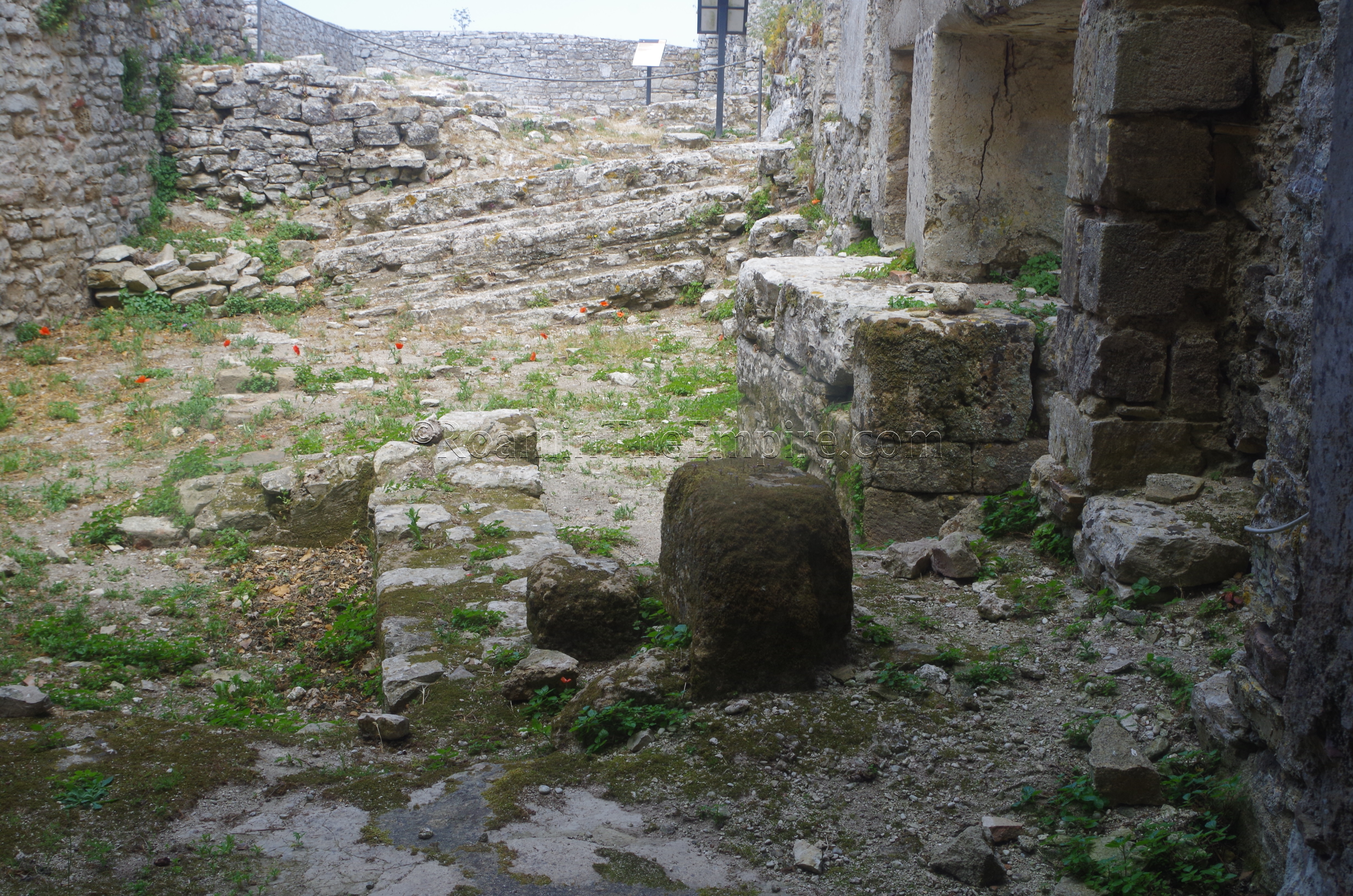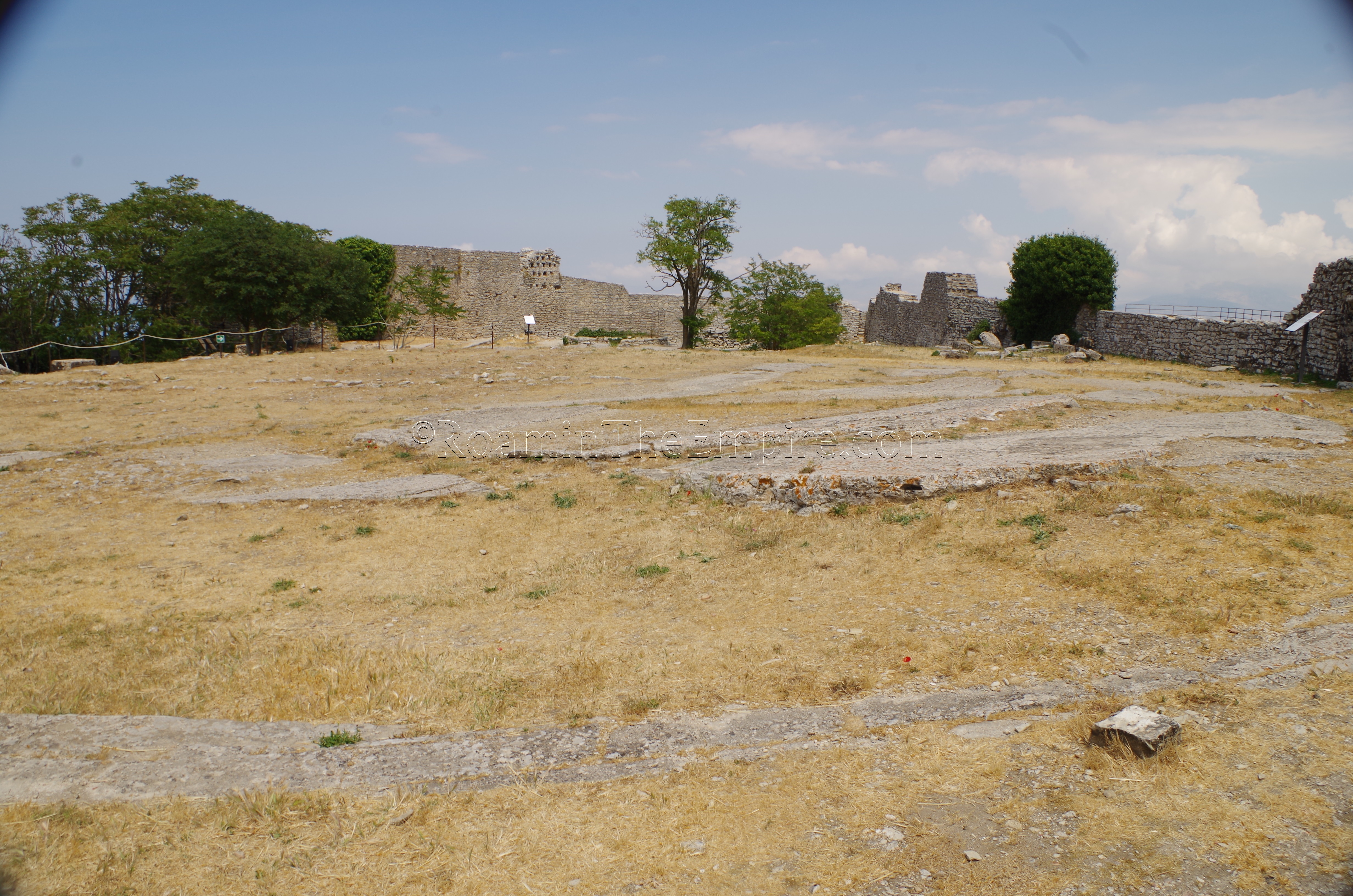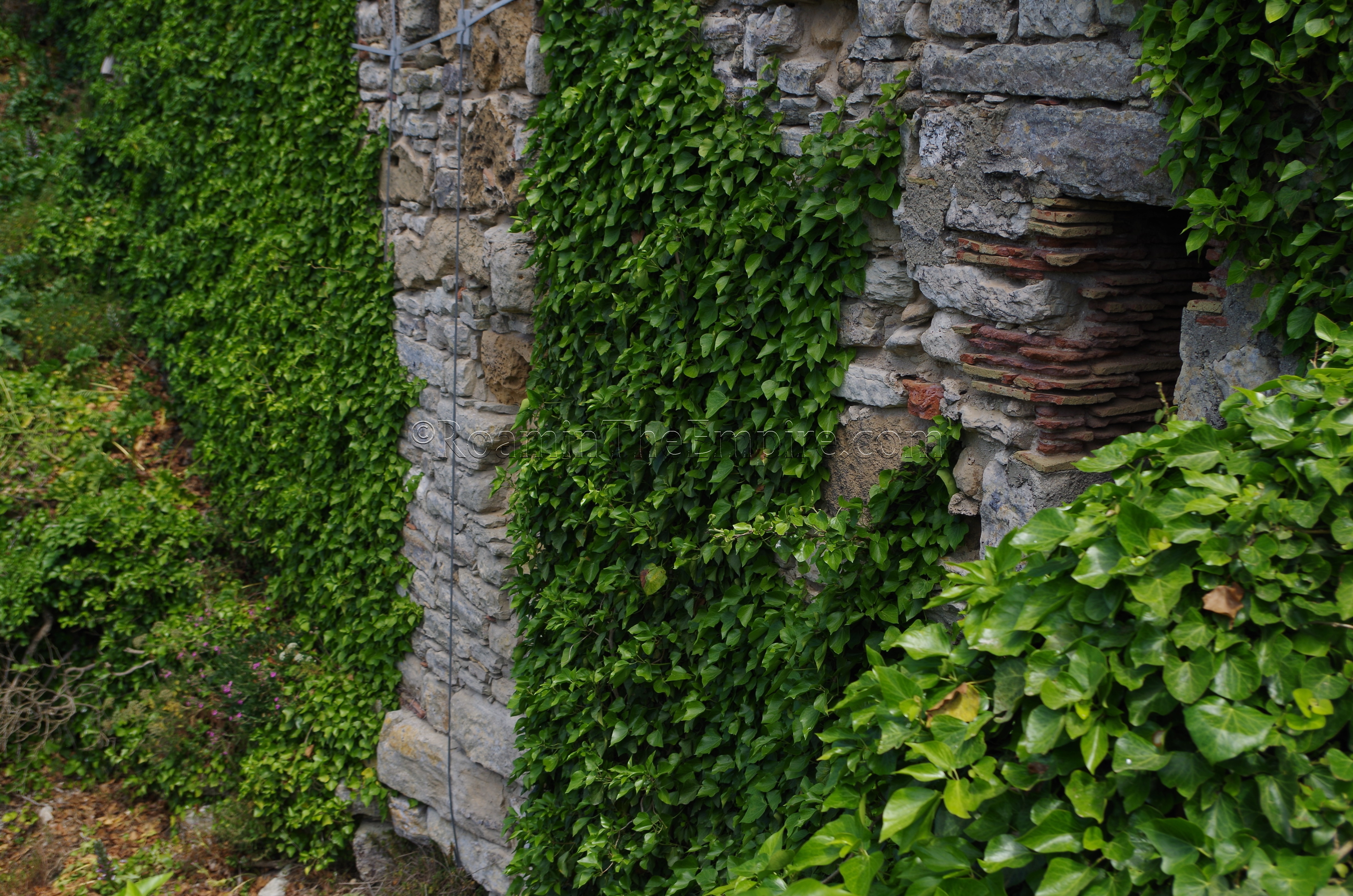
Most Recent Visit: May 2017.
Perched at a height of 750 meters, on a mountain overlooking the modern town of Trapani, is the town of Erice and the location of the ancient settlement of Eryx. Though the original settlement was probably founded by the Elymian people of western Sicily, mythological origins are also attributed to the foundation of the settlement. According to legend, the town was named after Eryx, the son of Aphrodite and Brutes the Argonaut, who died after a boxing match with Hercules and was buried at that location. The Aeneid places Eryx as the location of a temple to Venus/Aphrodite founded and constructed by Aeneas and his group during their stop in Sicily. The area is also supposedly the burial location of Anchises, and a modern cenotaph at the foot of Mount Erice, along the coast, commemorates this.
Eryx apparently served as the religious center for the Elymian people, whose political capital was in nearby Segesta. The Elymians do not appear to have been indigenous to the island or the Italic peninsula, but rather seem to have arrived on the island, possibly from the eastern Mediterranean, around 1100 BCE. The Elymians would claim Trojan heritage, something that is attested to in Thucydides, and which lead to favorable treatment under the Romans. The other pre-Roman/Greek/Carthiginian groups on the island, the Sicels and Siciani seem to have originated in Italy and either Iberia or Illyria, respectively.

Phoenician traders arrived on the western coast of Sicily, perhaps as early as the 9th century BCE, eventually founding a settlement at the island of Motya, about 20 kilometers south down the coast from Eryx. Shortly thereafter, Greek colonists arrived in eastern Sicily around the middle of the 8th century BCE. Though both the Greek and Phoenician cultures had significant impact on the local culture, the Elymians, perhaps as a matter of proximity, seem to have took more from the Phoenician side of things, and when conflict inevitably broke out between the Phoenicians and Greeks, the Elymians allied themselves with the Phoenicians and later the Carthaginians. By the middle of the 6th century BCE, with conflict growing between the cultural groups on the island, the Carthaginians claimed hegemony over the Phoenician and the local groups in the western part of the island.
Around 510 BCE, the Spartan prince Dorieus led an expedition to Sicily that resulted in the foundation of a colony, Heraklea, at the foot of Mount Eryx, perhaps with intentions of taking Eryx itself. This was promptly driven out by the Carthaginians. Infighting between the Ionian and Dorian Greeks in the eastern part of the island eventually drew Carthage and the Elymians into nearly 200 years of intermittent conflict for supremacy of the island between 480 BCE and 307 BCE, when the Carthaginians finally gained dominance over the whole of the island except for Syracuse. The relative peace on the island was short-lived as Pyrrhus of Epirus led an expedition to Sicily in 278 BCE against the Carthaginians, capturing Eryx as well as several other settlements before his treatment of the Greek populations on the island led to a withdraw of their support and forcing him to leave the island.

The common enemy of Pyrrhus initially led to an alliance between Rome and Carthage, but the complex political situation and prospect of unchallenged Carthaginian dominance on the island eventually led the two powers into direct conflict and the start of the First Punic War in 264 BCE. Eryx was firmly within the Carthaginian controlled part of the island for much of the conflict, but in the latter stages became a focal point in the closing actions of the war. After a significant naval defeat at Draepana (Trapani), the city at the southern foot of Mount Erxy and a failed attempt to take Lilybaeum to the south, the Romans seized Eryx and used it as a base to lay siege to Draepana in 248 BCE. Carthaginian pressure at Panormus (Palermo) forced Roman attention eastward, and the Carthaginians were able to besiege the Roman forces remaining at Eryx in 244 BCE and lasting until the end of the war. A Roman naval victory at the nearby Aegates (Egadi) Islands in 241 BCE, however, led the Carthaginians to sue for peace and resulted in Eryx and the rest of the island passing into Roman control.
The Elymian people enjoyed favored status under the Romans due to their claim of a shared Trojan heritage with the Romans. Eryx doesn’t feature in the historical record much after the First Punic War, though it is mentioned in the literature of Ovid and by Cicero. One historical episode did occur at Eryx during civil war between Marius and Sulla. After fleeing Italy, Marius stopped at Eryx for water on his way to Africa, but the landing party was attacked by the local quaestor. The attack inflicted casualties and forced Marius to try his luck elsewhere.
Getting There: The best way to reach Erice is via the funicular from Trapani. Though I don’t typically go this route, I booked a car for part of my time in Sicily, since public transport, particularly in the western part of the island, is a little bit limited. If traveling in a group, a car might be a worthwhile investment. That being said, I’ll attempt to provide some transport information, though I can’t speak to the realities of using it. Train service from Palermo to Trapani is rather long and limited, taking around 5 hours. A better option is the bus, which runs from the Palermo airport (which can easily be reached from the Palermo train station via bus) to the Trapani port, taking only an hour and ten minutes and costing about 8 Euros. The bus schedule is not very regular, so check the schedule here. Once in Trapani, the Line 24 bus will run from the port to Via Giovanni Battista Fardella, from which the Line 26 bus can be caught to the funicular station that runs up to Trapani. In the summer, Line 203 runs from the port to the funicular. The schedules for the Trapani busses can be found here. The funicular from Trapani to Erice takes about 10 minutes and costs 5 Euros each way or 9 Euros for a round trip. The funicular website lists seasonal times of operation for the cable cars as well as links for summer bus schedules that run to the station (here).

One of the most important monuments of ancient Eryx, the Temple of Venus Erycina, has all but disappeared under successive layers of occupation, though the 12th century Norman castle that now sits at the location of the temple bears the name of its predecessor; the Castello di Venere. Perched on a cliff on the west side of the town at Largo Castello, some ancient remains are still visible on the premises. The opening hours of the castle are rather complicated. In April, May, June, and October, it is open daily from 9:30 to 17:30. In July and September it is open daily from 9:30 to 18:30. In August it is open from 9:30 to 19:30. Between December 8th and January 7th it is open from 10:00 to 20:00, though between December 25th and January 1st, the hours are limited. The rest of the year it is open from Monday to Friday from 10:00 to 13:00 and on Saturdays and Sundays from 10:00 to 15:30. Entrance to the castle is 4 Euros. or a combo ticket that grants access also to the museum and a few other sites in town is 12 Euros.

The site of the Temple of Venus likely hosted similar deities prior to Roman control and influence; Astarte during the period of Phoenician and Carthaginian influence (evidence of an Astarte Erycina has been found elsewhere) and Aphrodite at some point. An unknown Elymian deity may have occupied the space prior to that. A church to Santa Maria delle Neve (St. Mary of the Snow) would occupy the site after the construction of the castle in the 12th century CE. Venus of Erycina as the particular aspect of the goddess worshipped here was known, became popular enough that two temple was built to her in Rome, the first on the Capitoline Hill by Quintus Fabius Maximus after consulting the Sybilline Books following the Roman defeat at the Battle of Trasimine in 217 BCE. The second was built by Lucius Porcius Licinius on the Quirinal Hill as fulfillment of a vow in 184 BCE. The Temple of Venus at Eryx is mentioned in Tacitus as being restored during the reign of Tiberius after a plea from the people of nearby Segesta.

As previously discussed, not much of the actual Temple of Venus remains, there do remain a few vestiges of both the Roman and Punic occupations of the settlement within the grounds of the castle, as well as a wall that was perhaps part of the circuit wall around the sanctuary. The temple is depicted on a denarius minted in 56 BCE as being a temple on a rocky outcropping surrounded by a circuit wall. Though most of the standing walls on the site are part of the medieval fortifications, a section of wall at the northern point of the grounds dates back much further. Named the Wall of Daedalus (Muro di Dedalo) in reference to the episode in Diodorus Siculus in which Daedalus is said to have landed at the sanctuary and strengthened the outer wall, the wall seems to date to the 4th-3rd centuries BCE, and very well could have composed part of the outer wall of the sanctuary.

Another structure on the grounds that may or may not be related to the temple is a large well in the eastern part of the castle. Called the Well of Venus (Pozzo di Venere), the actual date of construction of the 6 meter deep structure is unclear. While it is entirely possible that it could date back to antiquity, it is equally possible that it could date to a later period, as the continued use has led to more modern improvements that obscures evidence of the origins. Legend associates the well with a ritual bathing area related to the worship of Venus, while it could also have been used as a grain storage area. Later periods of use clearly indicate that it was eventually used as a cistern.

Back near the entrance into the castle courtyard and the Wall of Daedalus are a few areas that are identified as part of a Roman era bathing complex. A now mostly barren area immediately to the left of the entrance area has been identified as the caldarium of a bathing area. While there is not much visible now, the presence of pilae from the hypocaust system were found. Immediately adjacent to the caldarium, to the northeast was a room of unknown use that was paved in white mosaic tile, not much of which remains.

The final ancient remains on this site are the Punic era walls. Near the Wall of Daedalus, on the very northern point of the castle, is a section of the Punic era walls, but, they aren’t marked very well and don’t seem to be very visible from inside the castle. Another section adjacent to the caldarium is a bit easier to see, though not from the interior of the castle. This section of walls is best viewed from just outside the entrance to the castle, on the left side (when facing the castle entrance). Though when I visited there was quite a bit of vegetal overgrowth, the larger Punic blocks are somewhat visible along the lower portions of the wall.

Along the western side of Via Rabata, on the western side of the city are the remains of some of the city walls and defensive towers stretching for about 700 meters. Some of the larger blocks seem to belong to an 8th century Elymian building phase, while others belong to a 6th to 5th century BCE building phase by the Carthaginians. Some of those blocks apparently have Punic letter mason marks on them, though I was not able to find any. Though the actual masonry dates to early periods, the walls were evidently reconstructed in the Roman period and perhaps in later periods as well. The street runs along the inside of the walls while walking paths run along the exterior of this stretch of walls. The walls eventually deviate from the road in the north, but a walking path along the exterior of the walls continues.

There is a small museum at Erice, the Museo Comunale Antonio Cordici. The museum is located at Vico San Rocco I 1. Like the castle, the hours of operation for the museum are quite complicated. In April, May, June, and October the museum is open daily from 10:00 to 18:00. In July and September it is open from 10:00 to 19:00, and in August from 10:00 to 20:00. Between December 8th and January 7th it is open from 10:00 to 20:00, though between December 25th and January 1st, the hours are limited. The remainder of the year it is open from 10:00 to 14:00 from Monday to Friday and 10:00 to 16:00 on Saturday and Sunday. Entrance is 4 Euros, or a combo ticket that grants access also to the Castello di Venere and a few other sites in town is 12 Euros. Unfortunately, because of time constraints, I was not able to visit the museum, but, from what I gather, the collection of ancient artifacts is quite small.
Sources:
Diodorus Siculus, Bibliotheca Historica, 4.23, 4.78, 10.18
Hildinger, Erik. Swords Against The Senate: The Rise of the Roman Army and the Fall of the Republic. Da Capo, 2003.
Konrad, C. F. “Marius at Eryx.” Historia: Zeitschrift für Alte Geschichte, vol. 46, no. 1, 1997, pp. 28–63.
Livy, Ab Urbe Condita, 22.9, 23.30, 40.34
Plutarch, Life of Gaius Marius, 40
Plutarch, Life of Pyrrhus, 22
Polybius, Historiai, 1.55-58
Pratolongo, Valeria. “The Greeks and the Indigenous Populations of Eastern Sicily in the Classical Era.” Mediterranean Archaeology, vol. 27, 2014, pp. 85–90.
Rickards, O., et al. “Genetic History of the Population of Sicily.” Human Biology, vol. 70, no. 4, Aug. 1998, pp. 699–714.
Strabo, Geographica, 6.2
Tacitus, Annals, 4.43
Thucydides, History, 6.2
Traill, David A. “Boxers and Generals at Mount Eryx.” American Journal of Philology, vol. 122, no. 3, 2001, pp. 405–413.
Vergil, Aeneid, 5.387-420, 5.759


